Googling "brevet bike" takes you down a number of rabbit holes, most of which (by this point) I’ve been well-down and am done with. In truth (like everyone ultimately says), there is no "best brevet bike." All bikes are good bikes.[1] The best bike for a brevet is one you feel good on and about and is reliable. But I spend too much time thinking about this, nevertheless, given what I’ve got to work with, and what things I like. And I am feeling lazy and like jabbering and happened to have some photos kicking around, and so here are two options, to somewhat distinct ideas.
I mentioned that I forgot to take any pictures during the April Fool’s Day populaire, but as I was looking back through my photos I discovered that I had, in fact, at least taken a picture of the bike all cleaned up and ready to go:
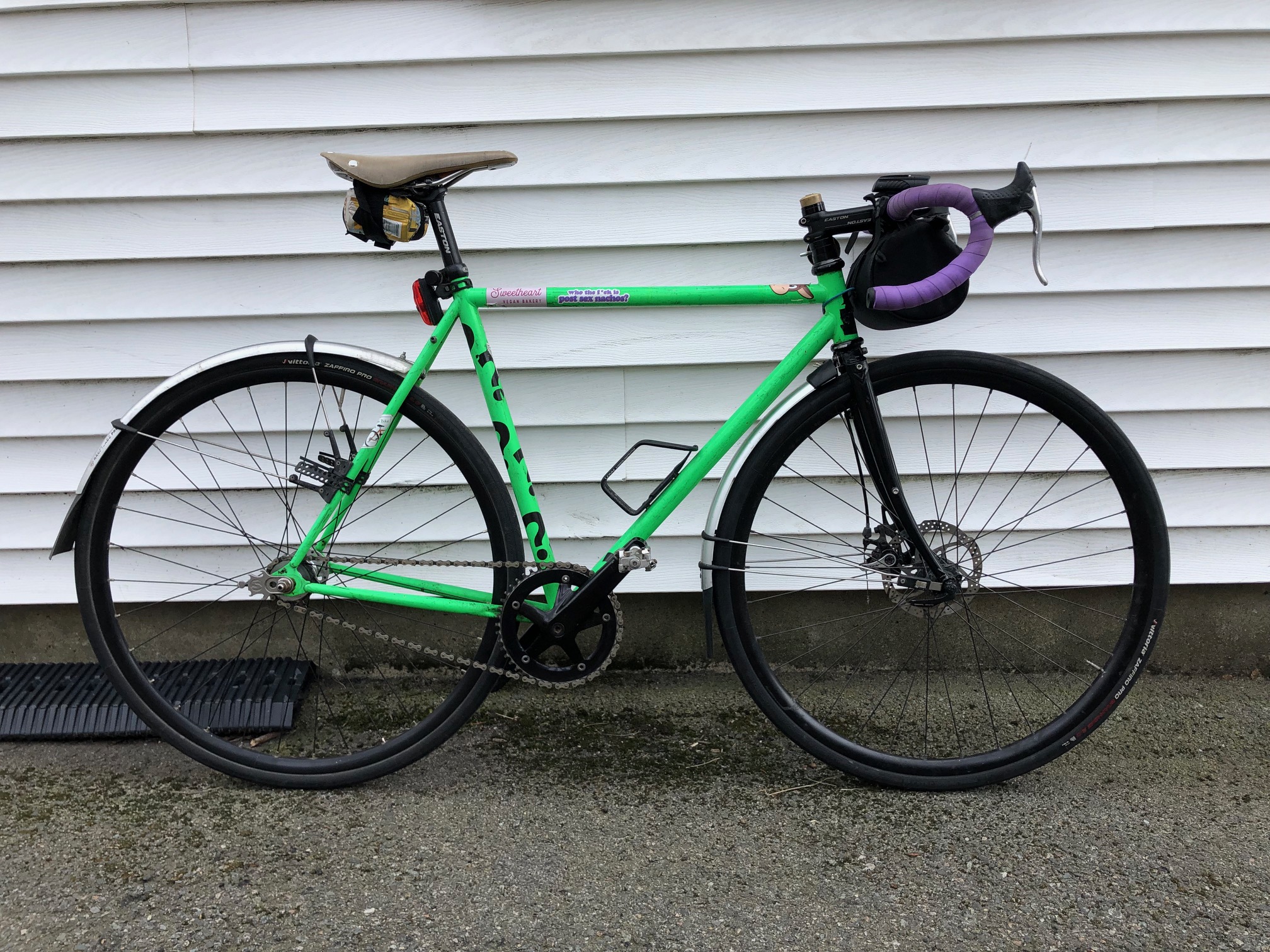
Some points of note (with some minor recapitulations from the ride post):
-
Gearing was 46-18, which was pretty perfect (or at least as perfect as a single option could be).
-
I ran brake hoods; normally I just use a cyclocross cross-top brake lever and keep the drops clean and "track bike looking," but for longer descents and the extra hand positions, you really can’t beat a pair of hoods. That said, these were really too narrow, at least for my hands, at least for what they expect these days. As you’ll see below, I prefer SRAM single speed levers (the aluminum ones, not the carbon ones, because of being financially responsible and valuing durability), and though the shorter reach of these is beneficial since normally I’d run a 90mm stem whereas this one is 100mm, my hands did cramp up just a little bit by the end. Still: great. And I didn’t have to spend any money trying to chase down another pair of levers.
-
The silly bartape. Partly this is in keeping with the "Riddler"/Batman theme of the bike (which I still don’t love, but as of yet have no interest in changing, even though I have cans of spray.bike ready and waiting). I got this tape for cheap money off Craigslist. It’s fine. I don’t love it, don’t hate it. Will probably replace with cloth tape again in the fall.
-
Fenders. I am particularly proud of these. The tl;dr is that I drilled holes in them and retrofitted a bunch of hardware I found in my junk hardware jar and basically made them much more secure than they would have been otherwise. Would it be better to have full-coverage fenders? Of course. Did these work well enough? Also of course.
-
Carrying capacity: limited. The contents of the bar bag (which I otherwise love) isn’t exactly super easy to access while riding, especially with wet gloves, and I only have eyelets for one bottle cage. That said, 100k is short enough, and the controls were close enough, that it really wasn’t an issue. This would not be a great setup, for example, for the 400k to Portland, ME, and back, since the last ~70 miles are without a control (and if you’re running late: no open stores, either).
-
I still think putting the disc fork on this bike was the best decision I ever made about it.
It was an excellent brevet bike for the day (as mentioned), and honestly I’d do more brevets on it, if I can get someone to drill in another pair of bottle cage eyelets. That said, in theory, I built that rear wheel I built with the fancy hub I built it with so that, again in theory, I can put that wheel on the Straggler for true fixed-gear brevet fun and freedom. There are some chainline questions I still have to sort out — and I’d need to remove or otherwise cover the rear brake caliper so it doesn’t get horrifically gunked up — but we’ll cross that bridge maybe next fall and/or winter. For now…
The Riddler has been relegated to trying-to-slow-down commuter mode:
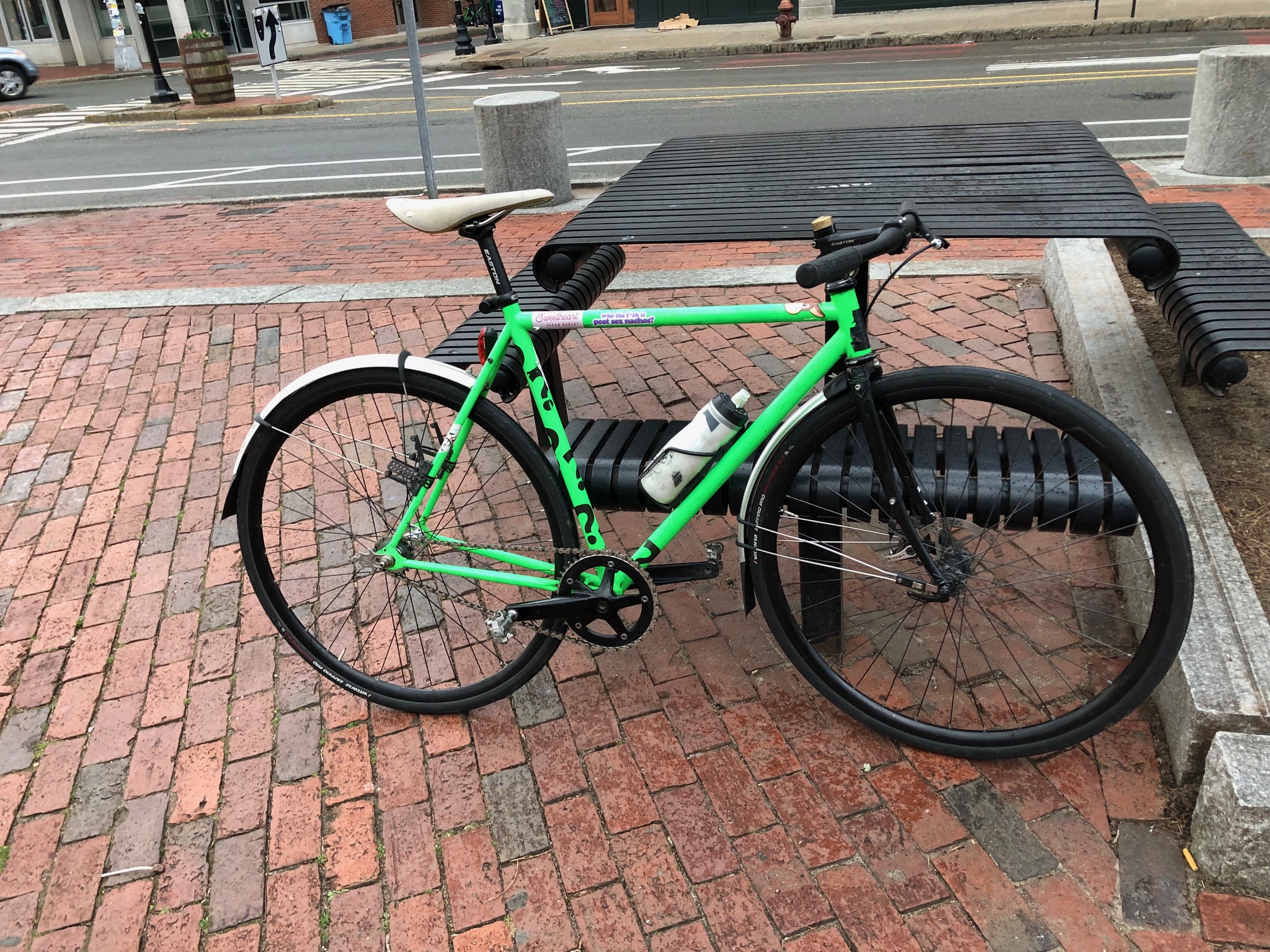
The Straggler, on the other hand, has been rebuilt to maybe it’s FINAL FORM:
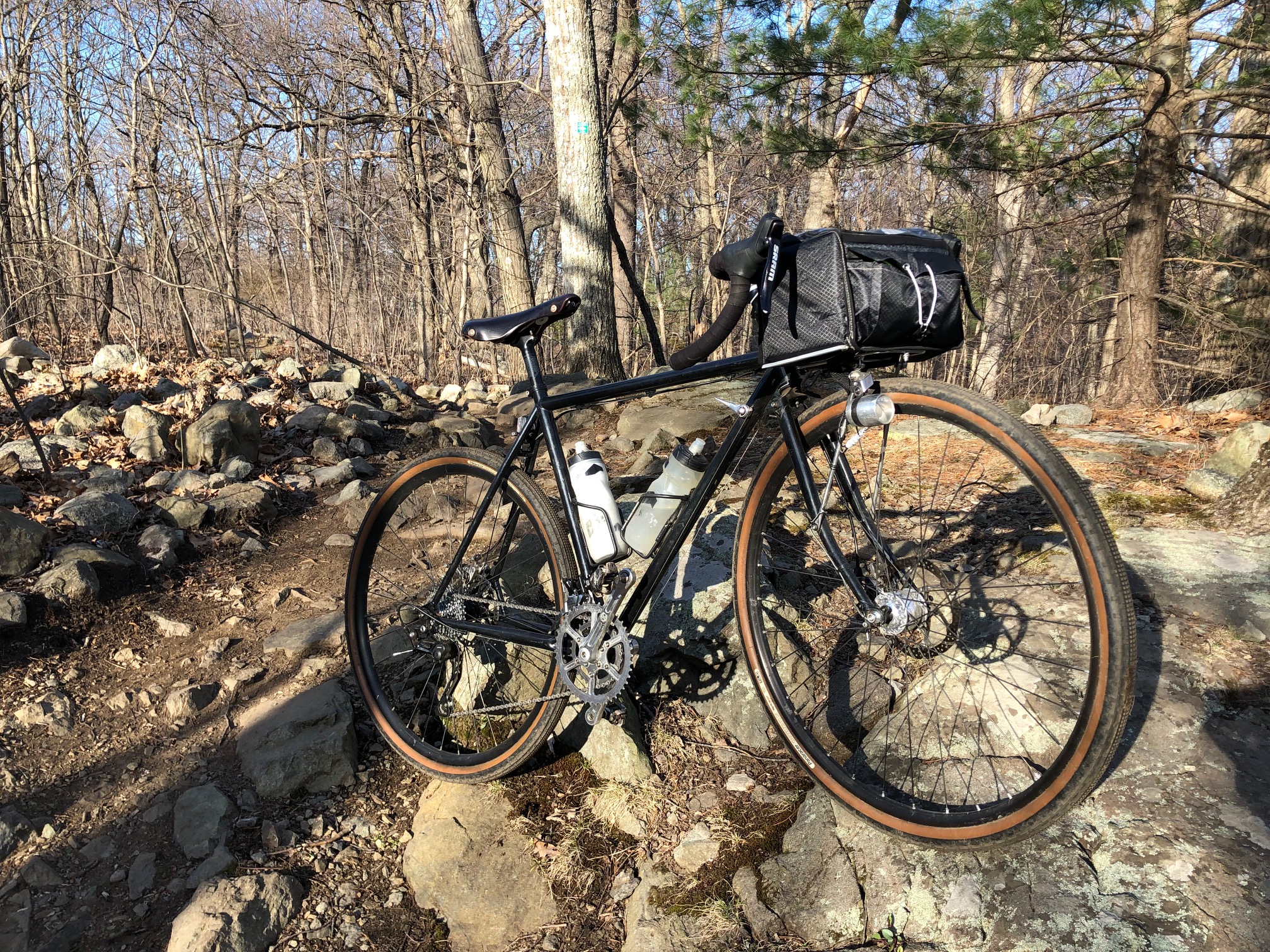
And of course, by "final form," I mean "final form for brevets and gravel." I still intend to run it single speed sometimes, and as mentioned I’m thinking about putting the fixed wheel on it (to leverage the dynamo lighting, comfort, an eventually-to-be-replaced fenders) for a winter commuter, but otherwise I think I’ve finally got the drivetrain I really want on there.
The build goes something like:
-
Shifters: Dia-comp ENE downtube
-
Front derailleur: SRAM Rival 22 (with slightly altered cable-routing), with chain catcher
-
Rear derailleur: Shimano GRX-400, 10-speed
-
Chain: Shimano Ultegra, 11-speed
-
Crankset: Velo-Orange Grand Cru 50.4 BCD, 46-30
-
Cassette: SRAM PG… something. Lightish. 11-32
-
Brake Levers: SRAM S-500
-
Brakes: TRP Spyre, post-mount, 160mm mismatched rotors and brake pads
Here are some "detail photos" I took during my shakedown ride the other day:
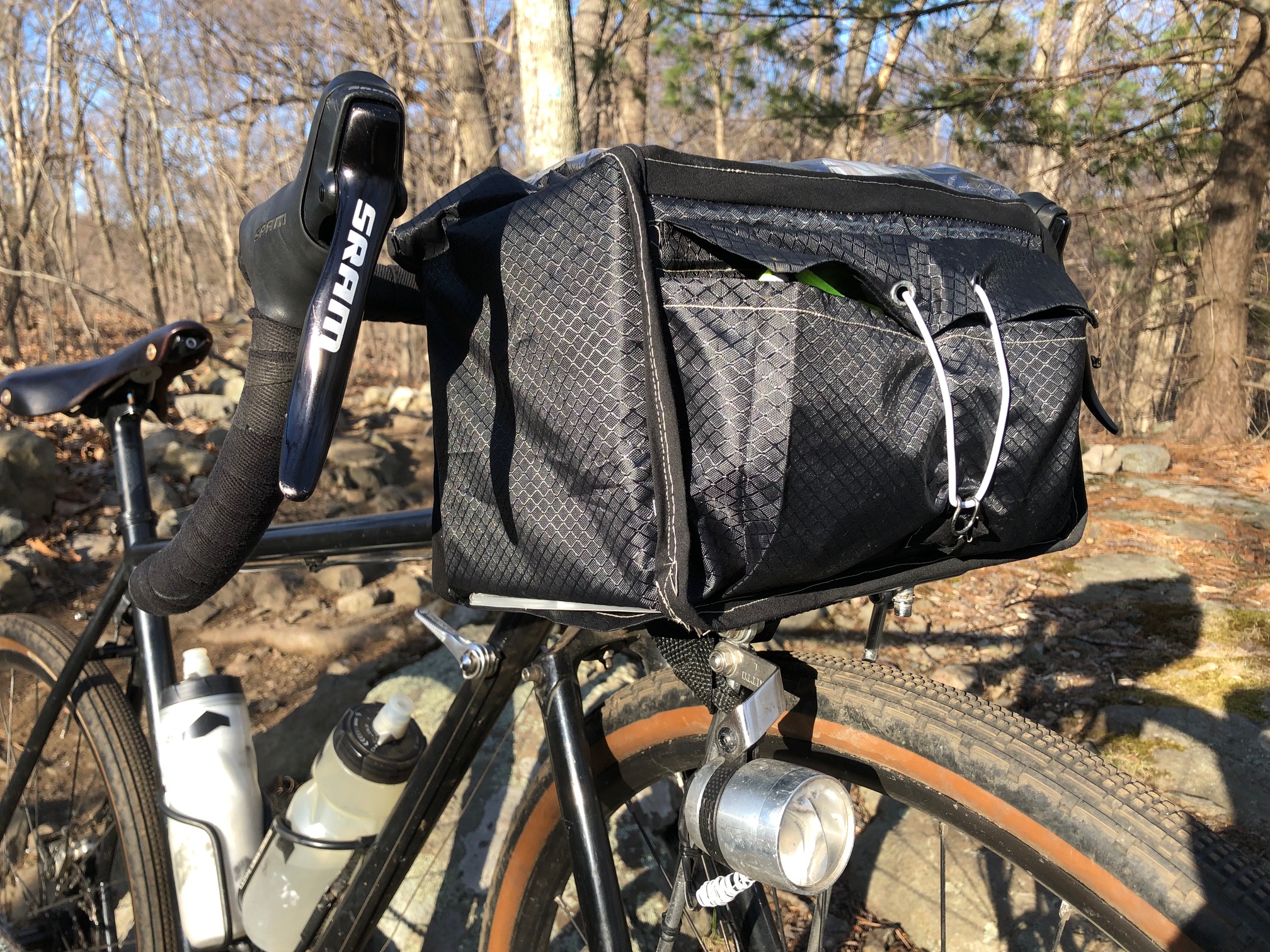
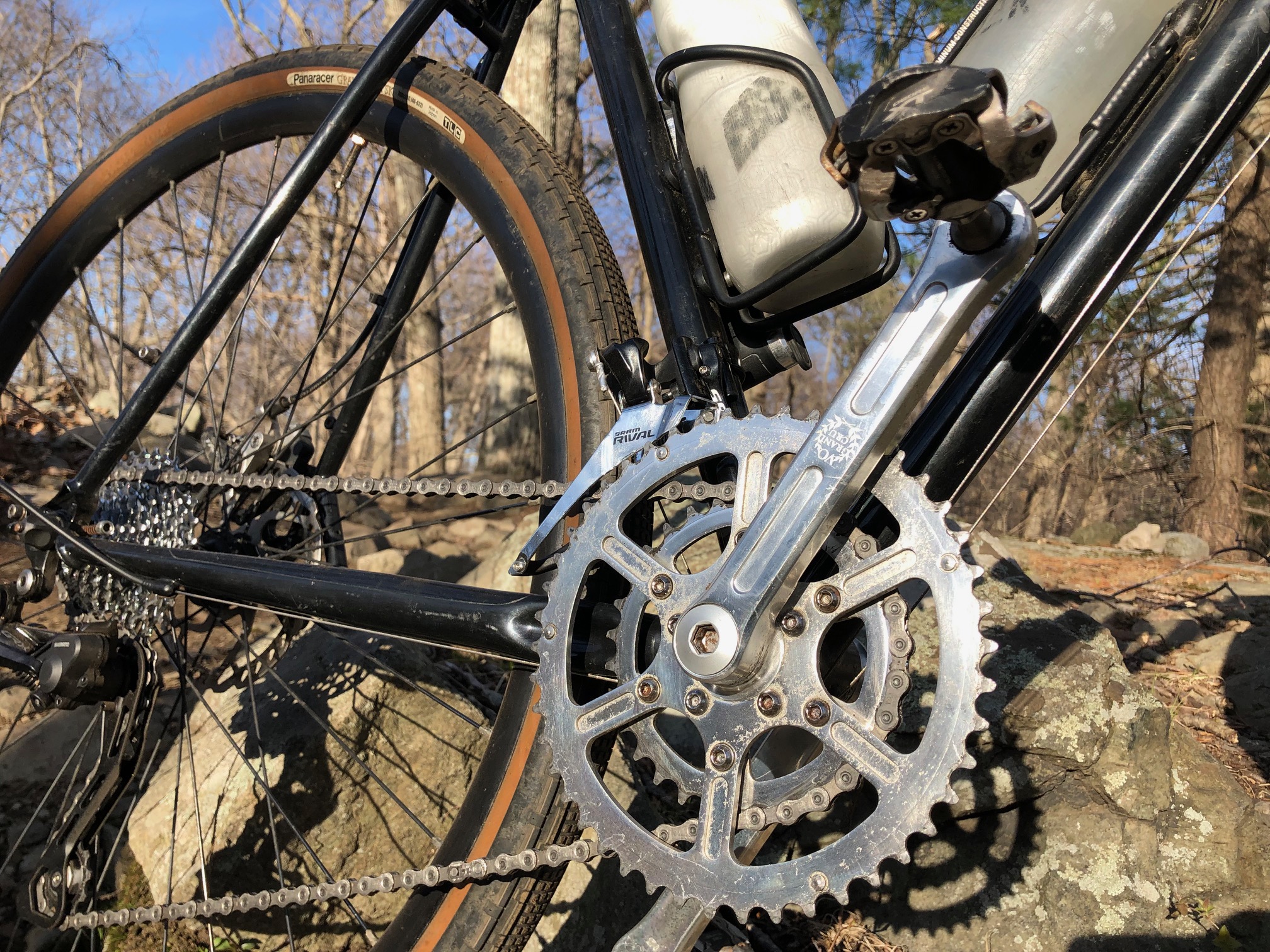

The shakedown ride itself was shorter than I meant it to be, but I managed to do a solid ~6-7 miles of dirt and singletrack, and everything performed flawlessly. While I originally had trouble with the front shifting, this was solved by taking the shifter apart and putting it back together (correctly this time, it turned out: explaining why it wouldn’t hold tension), and slightly adjusting the cable routing on the front derailleur to make it require more "pull," making it make more sense with a friction shifter. While I really did love the Shimano 6-speed-set-to-friction shifters that I pulled off of Alia’s bike when I put the flat bar stuff on it, it turns out that the Dia-comp shifters are a lot narrower/hold closer to the downtube, so I accidentally shift with my knees less, which is great.[2]
In all honesty, the GRX rear derailleur doesn’t hold the chain quite as quiet as the Rival 1 rear derailleur did, but I think this makes sense given that it can handle a 2x up front. It shifts well, no issues with the clutch on and in friction mode, and I like that I can handle a slightly bigger cassette in the back than I could with the Ultegra short-cage RD I ran last summer. It’s having a clutch means that I won’t have to change the drivetrain ahead of D2R2 or other more off-road adventures,[3] which means that this is much more of a "final" drivetrain version than last summer’s, which was pretty fucking good.
While I think I am almost strong enough to warrant going up a chainring size in the front (and if I ever get around to building up a go-fast road bike, I will certainly do larger than a 46T), this gearing works really well for me. I did raise the front derailleur slightly higher than the 1-2mm you’re supposed to keep it so that I could reach the 28T in back without the chain rubbing against the top of the derailleur,[4] but that’s about as low in the big ring as I’d want anyway, and the "yaw" on the front mech works as advertised, at least so far as I can access smaller cogs in the back when I’m in the little ring up front without too much hassle.
I’ll get many more miles this weekend and next week (and next weekend: the first proper brevet of the year) to confirm my findings, but as I’ve mentioned previously, friction shifting is a joy, the bike rides great, and it puts a smile on my face thinking about all the miles the bike and I have done together, the miles to come. I know it’s a great bike to ride brevets on, since it’s what I rode all last summer. The changes I’ve made are ultimately pretty minor (the front derailleur is still just a front derailleur, the rear gets maybe a little more range but is functionally still more or less the same), but it’s a tinkerer’s bike, and so why not tinker and play?